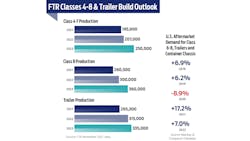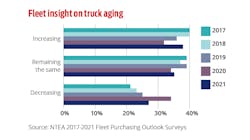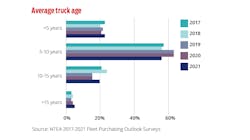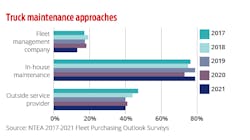The parts shortage situation in the commercial vehicle sector has become quite the quagmire: New trucks languish away in OEM lots waiting for semiconductors as fleets scrounge the web to find parts to free trucks from shop purgatory, or strip one truck to get another back on the road—literally robbing from Peter(bilt) to pay Paul in the name of uptime.
“It is like a Mr. Potato Head,” explained Cari Baylor, president of Baylor Trucking. “We are pulling our equipment and cannibalizing parts. We pre-bought parts and, over the past 90 days, we shipped out 57 parts to our partner dealerships. An OEM dealership doesn’t have the parts, so we are shipping it to our dealer locations to fix our equipment on the road.”
There are plenty of other anecdotal tales from shop, such as Quality Transport resorting to eBay for a marked-up water pump to get a truck out of Flagstaff, Arizona, to rumblings at the Technology & Maintenance Council Fall Meeting about diesel particulate filters costing twice as much as a year ago.
These survivalist means to an end are enough to make truck part customers feel like a hungry rat in a maze, trying to sniff out that elusive fuel injectors like a morsel of cheese.
How did we get here? And what can fleets’ parts departments do about it?
Neither answer is simple, but Fleet Maintenance has collected a variety of data and talked to several experts to hopefully shed some light on the issues, what’s coming next in the next few years, and more importantly, provide solutions to ensure the industry can get moving again.
In addition, because data is so integral to making sound purchasing decisions, we have put together a fleet purchasing study to add even more insights into the parts situation.
And maybe, by mapping every corner and crevice of this whole damn maze, somebody can find the exit.
It was the worst of times: An overview of the problems
With certain issues in the industry, such as the driver or technician shortages, there are dissenting voices who question the severity of the issue, arguing the real issue is shorting employees a proper salary. However, in regards to the current parts ordeal, there’s not a single source—from the OEMs and aftermarket to economists and fleets who we spoke to—who thought supply chain concerns are overblown.
Don Ake, VP of commercial vehicles at FTR Transportation Intelligence, said it’s “the worst supply chain crisis since World War II.”
He cited the backups at the Ports of Long Beach and Los Angeles, swelling from 40 container ships waiting to dock to 100 last October, as a major reason truck OEMs can’t keep builds up with orders.
“There is all this pent-up demand for commercial equipment—the problem is that it’s growing every month,” Ake said. “That pent-up demand is building and it is going to make it tough when things finally break loose to try to catch up.”
And this economist isn’t the only one.
“The parts availability issues in 2021 are pretty unprecedented,” explained Tim Meeker, director of product and pricing at Navistar. “At the root is a conflagration of business interruptions stemming from the COVID-19 pandemic going head-to-head with pent-up demand across virtually all industrial segments at once. It was a perfect storm.”
Molly MacKay, VP of operations at MacKay & Company, invoked similar symbolism, attributing the current climate to a “rainstorm of events.”
She cited supply chain constraints and shortages, parts issues, hiring issues, and inflation as factors. On the positive side, MacKay & Co.’s data found the total aftermarket value increasing 17.2% in 2021 after declining by 8.9% in 2020. The comprehensive report tracked over 800 truck, tractor, and trailer components across Classes 6-8 and several vocations and fleet sizes. Next year, MacKay expects a 7% increase.
As far as the parts shortage goes, semiconductors best represent the struggles. Along with the shocks of COVID shutdowns, there is just too much demand for chips in the automotive and consumer electronics space and not enough to go around due to the small amount of companies who make them.
And with freight rates so high, fleets want to buy more trucks, but they can’t, because they are parked near the plant awaiting chips. Kenny Vieth, ACT Research president and senior analyst, said the shortage could “hobble the industry well into 2022—and perhaps even beyond.”
SEMI, the sector’s trade association, forecasted that two dozen 300 mm chip fabrication plants would open up between the beginning of 2021 and end of ’22.
“We're using semiconductors as a catch all, primarily because semiconductors just go into so many parts,” Vieth told Fleet Maintenance. “One only has to look at steel or aluminum or other commodity prices to recognize that it's not just a semiconductor issue. And the problems aren't just U.S. problems or North American problems, but really global problems.”
In September, steel reached peak prices before dropping 8% in October, according to Ake. Meanwhile, aluminum prices spiked above $3,100/ton on October 18 before falling to around $2,700/ton on November 11, based on Markets Insider data.
Hendrickson’s Rence Oliphant commented that steel, which the OE uses for springs and other suspension parts, “has basically tripled or quadrupled since the start of the year.” Hendrickson sources its steel from North America, which has circumvented some of the port issues.
“We don't rely on the overseas and quite frankly, that's helped us and it's hurt our competition,” Oliphant said. “You look at all those ships off the Port of Long Beach right now. We've got drums hubs sitting there waiting to come on shore—nobody's transporting them in. So I think everybody's had a wake up call here that you can't be single source, you've got to have different locations.”
This isn’t the first tight spot the U.S. has found itself in, and as bad as things appear, they are not WW II bad.
“I'm optimistic about the future because these things will ultimately sort themselves out,” offered Vieth, finishing with an Alan Greenspan, quote. You know, the law of supply and demand has not been repealed.
“If we as business leaders accept that our global economy is subject to a repeat of such risks in the future, then continuity of operations and service level becomes a focal point,” Meeker said. “I would expect that businesses will focus on redundancies in the future, whether that means keeping multiple suppliers active in different parts of the world or starting to look at making better use of manufacturing methods such as additive manufacturing.”
Backlog to the future: The truckbuilder corner
“Demand is just through the roof; now we're trying to figure out supply,” ACT Research's Vieth said. He said factories “swimming in inventory” are laying off workers, and when the plant needs labor again, it will be difficult to find it.
Backlogs are also mounting, like rising waters behind an old dam.
Citing ACT Research data going back to the 1980s, Vieth said the medium-duty backlog is the highest it has ever been.
For September 2021, the Classes 5-7 backlog (trucks, buses, RVs) was at 145,200 units. Compare that to the previous peak, the pre-buy cycle prior to the 2007 emissions standards went into effect, when medium duty backlog was at 101,500 units.
“The last four months, the industry has been building about 19,000 trucks a month, and the order rate has been 27,000 trucks a month,” Vieth said. “Right now, there’s a 145,000-unit backlog. In March, it was a 99,000-unit backlog. That’s 8,000 units a month in backlog growth.”
The medium-duty backlog to build ratio, the time it takes clear the current backlog, is typically under 3.3 months or lower. It will take eight months to clear the September backlog, Vieth said.
ACT Research data showed backlogs in the Class 8 market reached 279,300 units, 7.5% off the all-time record of 302,100 set in October 2018. The backlog-to build ratio is at 12.6 moths.
The disparity is narrowing in the Class 8 market. The Class 8 orders in September were 27,300, down 26% from the monthly average over the past 12 months of 36,800. Builds in September reached 22,200, a slight improvement over the 21,800 units per month average over the last 12 months.
“Given carrier profitability, freight volumes—everything you want to look at it in the freight market, we should be seeing record-level orders right now,” Vieth surmised. “The only thing that's standing between record-level orders and record backlogs is the OEMs themselves; they’re not going to over promise their backlog until they have better visibility on [the current supply chain environment].”
Vieth said some OEMs are more willing to open backlogs than others, adding trailer manufacturers have also pulled back, otherwise there would be record backlogs there, too.
Overall, Hendrickson’s Oliphant, an industry veteran of 30 years, said the OEMs scaling back orders and build rates have actually had a positive effect on the OE.
“That has allowed a couple of our plants to catch up a little bit and get on top of things,” Oliphant said.
Still, from his vantage point, the industry overall has a struggle ahead.
“We've never had this much demand and not been able to fill it,” he said. “Fleets are making so much money because the rates are high that they want to buy equipment—they want to stay on their trade cycles. They also want the depreciation that comes with the purchases, and they're unable to get it because they can't get new trucks and trailers.”
Looking ahead, fleets in certain states in California, New York, and New Jersey will see a pre-buy prior to 2024 California Air Resources Board NOx emissions rules taking effect. Vieth said this could impact 15% of the U.S. market. “It's going to be made more difficult, because the industry is going to be trailing a lot of pent-up demand into 2023, so it's going to be harder to pre-buy.”
Oliphant said these trucks will cost $30,000 more, not including the expected added operational cost of $15,000 over the first three years.
“Will we see a 360,000 truck build in 2023?” Oliphant asked. “We’ve got to ramp up to it at some point next year.”
From harmony to chaos: The part supplier side
It used to all be so straightforward. Need a part? Call up the local supplier and a van could deliver it before you hang up the phone.
“The parts shortage was never in the equation; [customers] always knew parts were available, they just needed to get it repaired and back on the road,” lamented David Seewack, CEO of FinditParts on an October webinar hosted by Fullbay, which developed a heavy-duty shop management platform of the same name.
Seewack, a veteran of the parts industry for 25 years, explained one of the challenges is finding distributors who have parts in stock. Having 20 suppliers for one part was the norm, but recently only one of 14 suppliers of a Hendrickson part has it in stock.
Fullbay was announcing the beta version of FullBay Marketplace, which streamlines the heavy-duty parts ordering process from 10 steps, including calling a supplier, finding alternative sources, cross-referencing parts numbers, getting an estimated time of arrival and more, down to a three-step process: search, select, and order. The key is providing visibility into a distributor’s real-time inventory. FinditParts, which has a database of 10 million OEM and aftermarket parts, was the first parts provider to integrate the new tool for Fullbay customers. The ecommerce site offered 2.5 million parts in 2013.
“With the parts shortage and everything, we're working to try to be creative about solutions that can help get parts sourced faster,” said Fullbay Executive Chairman Jacob Findlay, who worked for a year in a Phoenix-area repair shop to understand the potential customer base prior to launching the company.
That is to make up for the fact that certain flaws of just-in-time manufacturing, the solution to rising inventory costs, were exposed by COVID.
“You don't want to have huge warehouses full of the different components that are needed to assemble the truck,” Findlay explained of just-in-time. “You want the delivery, ideally, for that specific component to show up on the assembly line exactly when you need it.
“Deliveries happened like clockwork,” he continued, “But as soon as we started to see the disruption, the most random components that you would never expect were experiencing a shortage.”
He said it’s more than just semi-conductor chips, but also several parts.
“One little disruption in the global supply chain has a ripple effect across the board, and it's not just one disruption—it's multiple” Findlay said. “A return to the harmonic balance that we had pre-COVID is going to take a while, and in the meantime, there's just a lot of chaos.”
Some of that chaos includes commercial vehicles not as well maintained. He pondered how quickly non-critical preventive maintenance tasks, which could turn into bigger problems down the road, would be completed
Part provider FleetPride recently came out of beta on its ecommerce site. This allows customers to search for more than 176,000 parts on Classes 6-8 vehicles and heavy-duty trailers. Search fields include part number, cross reference, year/make/model/engine type, and VIN. Alternative parts and associated parts are also recommended.
While FleetPride is “not immune” from challenges, according to Mike Harris, SVP of sales and operations for FleetPride, the company can leverage the scale of its network—280+ locations and five distribution centers— to have the inventory that customers regularly ask for.”
Harris said another key is that if a part cannot be found locally, a parts expert on the phone or webchat can “within just a couple keystrokes, source that part from a nearby store, or a store across the country, or a nearby distribution center as well.”
Leading the way: The Aftermarket angle
FinditParts’ Seewack mentioned how suppliers were running low on a Hendrickson part. Hendrickson’s Rence Oliphant acknowledged supplying to the aftermarket sector has faced difficulties in the wake of the COVID-19 plant shutdowns.
OEMs also take precedence over the aftermarket. And along with the semiconductor shortage, there have also been material delays, such as with rubber, because supplier Hexapol’s rubber compounding plant in Tennessee caught fire last January.
“I am happy to say things are actually getting better for us right now,” Oliphant said. “The lead times are starting to shrink back a little bit, so that's the good news. I think we may have hit the peak and we're coming back down to reality and normalcy again.”
Fellow suspension OE Link Manufacturing has also expressed positivity, with aftermarket lead time returning to normal after seeing them expand from one week to four. Components sourced from overseas had affected those.
“Link overall has been in pretty good shape,” said Mark Molitor, senior product manager for chassis at Link. “On the suspension part of it, we've got a really strong U.S. manufacturing and supply base.”
Molitor said Link has a 99.8% on-time delivery rate.
The lack of semiconductors for smart products has caused an exorbitant rise in price, said Link’s VP of business development, Brian Kujala.
“We're running into that right now where we have chips that you typically pay less than $1 for, you're paying over $20—and that's one out of 96 chips on our board,” he said.
This could impact vehicle prices in Q2 of 2022.
“I think you're just going to run into some near term, temporary, inflated pricing. That should, over the course of 2022, level itself out at some point,” Kujala concluded.
Common wear items, such as brake drums, have also been harder to come by.
“Brake drums, both domestic and imported, are three to four times beyond their normal lead time supplier commitments,” said Todd Shakespeare, Director of Parts Marketing, Volvo Trucks North America, which offers the Road Choice aftermarket brand. “This looks like it will improve in 2022 but will not reach normal levels until later in the year.”
There are still labor issues at the ports, fleets, and warehouses, Shakespeare noted.
“This, I believe, needs to be on the forefront of the efforts to improve,” he said. “If we do not have human resources, nothing else matters.”
The other thing is to rethink the supply chain reliance on just-in-time. This time it was a pandemic; next it could be a natural disaster.
“If we as business leaders accept that our global economy is subject to a repeat of such risks in the future, then continuity of operations and service level becomes a focal point,” Meeker said. “I would expect that businesses will focus on redundancies in the future, whether that means keeping multiple suppliers active in different parts of the world, or starting to look at making better use of manufacturing methods such as additive manufacturing.”
The way out?
So all this sounds like a supply chain "Squid Game," where threats lurk around every corner. And like in that dystopian game of life or death, forging relationships is a solid plan to survive long enough to make it out of this maze.
The longer those relationships have been, the better position the shop is in, regardless of size.
On one of her frequent visits to shops, specifically to one in Northern Illinois, MacKay noticed this was true.
“He gets four or five deliveries a day of parts that other people can't get,” MacKay recalled. “Dealers are calling him in order to fulfill their part needs."
She asked, “How on earth are you able to do this?”
He replied, “Relationships. I know where to go. I know who to call. I have people that can make this happen for me.”
This is not all that common in an industry with a lot of turnover, MacKay explained, which gives him an advantage.
“Because this guy has been in his position for decades and built relationships over those years, he's able to reach out and get what he needs,” MacKay said.
She said the ability to build and maintain relationships “is definitely not something that's going to show up on the books or on an inventory sheet, but it certainly plays an influential role.”
While soft skills are important, software may be more so. Leveraging ecommerce platforms can give parts customers real-time visibility into supplier inventory and allow them to quickly find what they need, though not enough allow that, FullBay’s Findlay said.
“Probably 80% of the parts to get ordered don't require a phone call into the distributor, and yet they require a phone call into the distributor to order it anyway,” he explained. “They could eliminate a ton of the work there by just opening up their platform to allow others to connect into it to enable ordering—and the first ones to do it are going to get way more business because they're adopting the technology.”
Findlay suggested the industry should rethink parts fitment and “get more aggressive at adopting ACES and PIES standards for heavy-duty, so that it doesn't require a human and tribal knowledge to identify a part.”
He thinks that could reduce the amount of times a customer requires human intervention from the theoretical 20% leftover from improved ecommerce visibility to 5-10%.
That’s currently out of the control of shops, but Findlay said what they can do immediately is expand their vendor list and think outside of their comfort zone.
These include local commercial shops, competing fleets, or independent shops, non-local vendors, online sources such as Amazon or Craigslist, or even salvage yards.
“Do you go get some old trucks that match pretty much what you already have in your fleet and just park them for parts?” Findlay asked.
He admitted these are “non-sexy, not super exciting suggestions, but very pragmatic.”
They’re also a little better than stripping your own trucks for parts, considering they will be much harder to come by for the next few years.
About the Author

John Hitch
Editor-in-chief, Fleet Maintenance
John Hitch is the award-winning editor-in-chief of Fleet Maintenance, where his mission is to provide maintenance leaders and technicians with the the latest information on tools, strategies, and best practices to keep their fleets' commercial vehicles moving.
He is based out of Cleveland, Ohio, and has worked in the B2B journalism space for more than a decade. Hitch was previously senior editor for FleetOwner and before that was technology editor for IndustryWeek and and managing editor of New Equipment Digest.
Hitch graduated from Kent State University and was editor of the student magazine The Burr in 2009.
The former sonar technician served honorably aboard the fast-attack submarine USS Oklahoma City (SSN-723), where he participated in counter-drug ops, an under-ice expedition, and other missions he's not allowed to talk about for several more decades.




